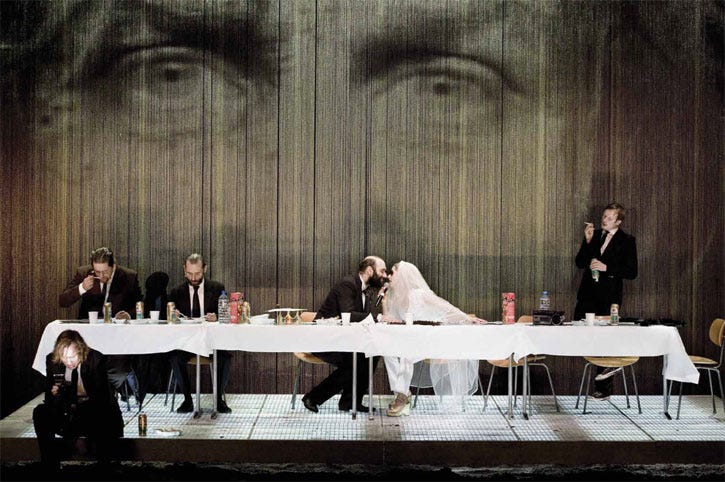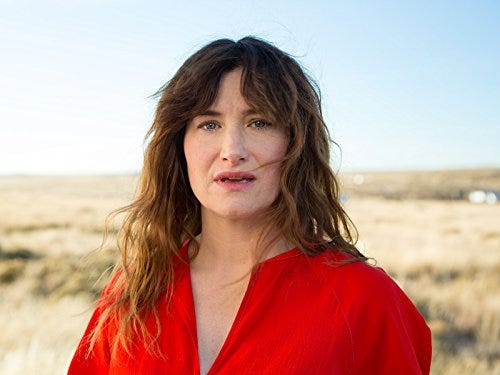The plays the thing
My obsession with ♱ German Theatre ♱.
Let me take you back to 2010.
I’m in my first year of professional practice and I’ve just paid an inordinate amount of money to see Schaubühne’s HAMLET as part of Sydney Festival at the Roslyn Packer Theatre. I’d been entertaining an obsession with Director, Thomas Ostermeier throughout my undergrad and scavenging for clips of anything from his oeuvre that I could find on YouTube. This production stars the extraordinary Lars Eidinger in the title role. It had been touring the world, and I was beside myself with excitement about seeing it in the flesh. It did not disappoint (this is an understatement).
Jan Pappelbaum’s set for HAMLET — an open graveyard — became a giant playground for Ostermeier’s actors to roam.
A colossal gold-beaded metal curtain trucked upstage and downstage on runners at either side of the earth-covered playing space, which doubled as a projection surface for live-feed. A wedding banquet table, also on runners that trucked over the graveyard, gave the actors a space to gather, feast, and celebrate.
I sat, mesmerised, for three or so hours, as actors ad-libbed; broke the fourth wall; traipsed through the audience tormenting patrons; doubled as other characters (Judith Rosmair’s transformation from Gertrude to Ophelia is particularly notable); slipped between delivering Shakespeare’s text in German and direct address in English; and tore off fat suits while lip-synching to pop songs. This staggering re-imagining of Shakespeare’s text was deeply contemporary, unashamedly playful, and experiential in a way that enhanced the story-telling without sacrificing narrative.
Ostermeier’s political core values are united in the notion of ‘realism’ that underpins his work, which he understands as something very different from ‘kitchen-sink realism’ or plain naturalism. As Artistic Director of the Schaubühne (1999-present), he revised the company’s mission statement to include a dedicated commitment to this specific (neo)realist approach. His work is not predicated on realistic aesthetic devices - instead, the space (both physical and temporal) becomes a generative playground, driven by the actors as creators.
Basically, chaos ensues and magic happens.
This de-naturalisation of our standard perception (as spectators, consumers etc) may result in reflection, insight, a critical attitude, and potentially even an act to make a change. Peter M. Bonesich calls it an “aesthetico-political pursuit of staging drama”.
This HAMLET was radical, confrontational, and very, very funny. The production challenged aesthetic conventions whilst structuring an identification with Shakespeare’s text that remained compatible with a realist framework. It contested the tired representational strategies of a dated form of social realism — propelling us forward into uncharted territory. I was similarly undone by Benedict Andrews & Maja Zade’s MOVING TARGET (2008), which infected me with a thirst for making that I’ve not been able to shake since.
All of this is an insight into who I am and the kind of work/practice/process that stirs me. Meg recently suggested that I start chasing this high in the intersection between theatre and screen based practice(s) in Australia in my work at Unless. I’m not just talking about meta-theatricality or blended genre, both of which are inherently theatrical and available to us right now - yes, I am one of the many people who recently INHALED Station Eleven. I’m also not suggesting we film theatre and stream it live - National Theatre Live in the UK does this brilliantly, and other major companies have begun to follow suit. No, I am (tentatively, with curiosity leading the charge) proposing we mine the space between these two artforms and smash them together to see what cracks open, spewing forth possibilities for innovation, interrogation, and play.
For me, the ‘play’ is absolutely the thing.
As I dive further into screen, I recognise gestures towards a fusion of the two mediums in the minutes leading into Hagai Levi’s Scenes from a Marriage where we see the actors, their mobile phones and cups of tea in hand, before they cross the threshold into the lives of their characters. We see it in Robin Wright’s soliloquies in House of Cards, or every time Phoebe Waller-Bridge breaks the fourth wall in Fleabag.
We see glimmers of it regularly. But I want to push it further. What if the two artforms could speak to each other and create a new space for discovery? What if blended form is the new frontier for story-telling and we’ve only just scratched the surface?
Keen to hear what you think.






